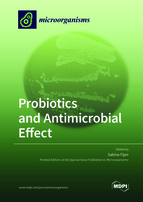Probiotics and Antimicrobial Effect
A special issue of Microorganisms (ISSN 2076-2607). This special issue belongs to the section "Food Microbiology".
Deadline for manuscript submissions: closed (31 July 2022) | Viewed by 37057
Special Issue Editor
Interests: probiotics; beneficial microbes; antimicrobial effect; lactobacilli; bifidobacteria; fermented foods
Special Issues, Collections and Topics in MDPI journals
Special Issue Information
Dear Colleagues,
According to the definition accepted by the WHO and FAO in 2001 and the grammatical update conducted by the Panel of the International Scientific Association for Probiotics and Prebiotics in 2014, probiotics are defined as “live microorganisms that, when administered in adequate amounts, confer a health benefit on the host.” The antimicrobial or antagonistic activity of probiotics is an important property that includes the production of antimicrobial compounds, competitive exclusion of pathogens, enhancement of the intestinal barrier function in resisting pathogens and others. There are many methods to ascertain probiotic properties, including various in vitro and in vivo methods. The in vitro methods include various modifications of the spot‐on lawn assay, agar well diffusion assay (AWDA), co‐culturing methods, usage of cell lines and others. The in vivo methods utilise animal models; however, their use is being restricted according to the European legislation OJ L136. The most important studies are double‐blinded randomized placebo controlled clinical trials; however, these studies are difficult to perform as it is not easy to achieve uniform conditions. There is a clear need for more elaborate assays that would better represent the complex interactions between the probiotics and the final host.
Our issue would mainly focus on:
1. The antimicrobial or antagonistic activity of probiotics.
2. The methods to ascertain probiotic properties, including various in vitro and in vivo methods.
Dr. Sabina Fijan
Guest Editor
Manuscript Submission Information
Manuscripts should be submitted online at www.mdpi.com by registering and logging in to this website. Once you are registered, click here to go to the submission form. Manuscripts can be submitted until the deadline. All submissions that pass pre-check are peer-reviewed. Accepted papers will be published continuously in the journal (as soon as accepted) and will be listed together on the special issue website. Research articles, review articles as well as short communications are invited. For planned papers, a title and short abstract (about 100 words) can be sent to the Editorial Office for announcement on this website.
Submitted manuscripts should not have been published previously, nor be under consideration for publication elsewhere (except conference proceedings papers). All manuscripts are thoroughly refereed through a single-blind peer-review process. A guide for authors and other relevant information for submission of manuscripts is available on the Instructions for Authors page. Microorganisms is an international peer-reviewed open access monthly journal published by MDPI.
Please visit the Instructions for Authors page before submitting a manuscript. The Article Processing Charge (APC) for publication in this open access journal is 2700 CHF (Swiss Francs). Submitted papers should be well formatted and use good English. Authors may use MDPI's English editing service prior to publication or during author revisions.
Keywords
- probiotics
- antimicrobial effect
- in vivo methods
- in vitro methods
- clinical studies







